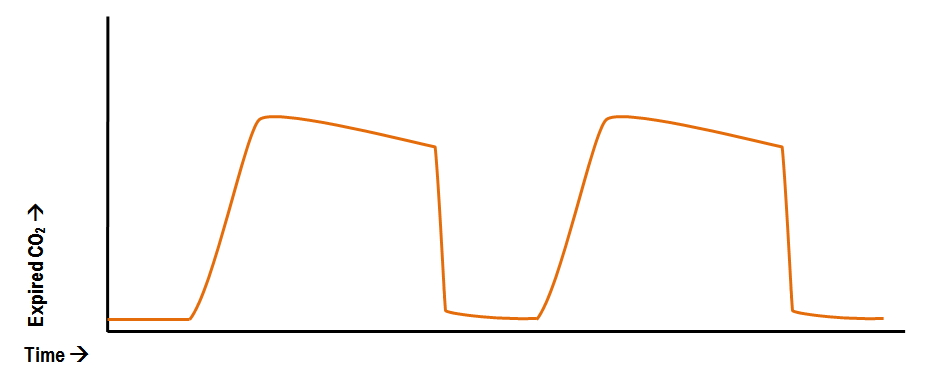normal end tidal co2 dog
Carbon dioxide is the end product of aerobic cellular metabolism the function of cells that require. End-tidal carbon dioxide ETco 2 monitoring provides valuable information about CO 2 production and clearance ventilation.

Learn More With This Respiratory Article By Melissa Marshall
Systole represents cardiac contraction and diastole occurs during cardiac filling.

. An increase of 10 mm Hg above normal is mild hypoventilation and an increase of 20 is severe. 1820 The normal range for ETCO 2 in mammals is 35-45 mm Hg. Carbon dioxide during ventilation.
The end-tidal level of carbon dioxide is generally less but is reflective of carbon dioxide in arterial blood and can serve as an indirect noninvasive method of assessing the adequacy ventilation. Hypercapnia in Dogs. Negative Epigastric sounds Equal lung sounds Esophageal detector.
2 See Figure 1 p. The normal end-tidal capnography wave form is basically a rounded rectangle. Pulse pressure is a result of the difference between the systolic and diastolic pressures.
Lydia Love DVM DACVAA. The normal levels of expired CO2 in dogs and cats should between 35 and 45 mm Hg millimeters of mercury. Normal range is 35-45mmHg and roughly correlates with the partial pressure of CO2 in arterial blood remember that PaCO2 is usually slightly higher than ETCO2 by 2-5mmHg.
While this may not be considered normal it may be a normal. There was an excellent linear correlation between PetCO2 and the PaCO2 over the entire range of CO2. The end-tidal carbon dioxide tension PetCO2 measured after a single large tidal-volume breath 15 mlkg body weight was compared to simultaneous measurements of PaCO2 in 6 dogs with normal lungs who were receiving high-frequency jet ventilation HFJV.
In a review study of 1281 dogs undergoing general anesthesia 63 of dogs experienced hypoventilation. Carbon dioxide is a normal part of the atmosphere and a normal component of the chemical make-up of the mammalian body. Values for hypercapnia range from 65-75 mm Hg.
Jun 22 2008. End-tidal carbon dioxide EtCO 2. CO2 is produced in the tissues is carried by the vasculature and is eliminated by the lungs.
PaCO2 PetCO2 End tidal measurement from expired or exhaled air PaCO2 Arterial blood gas sample End tidal normally 2-5 mmHg lower than arterial Comparing Arterial and End-tidal CO2 Review of Airway Confirmation Visualization Auscultation. 1 End-tidal CO2 usually underestimates PaCO 2 by 2-5 mm Hg in mammals. 302 - 1 mmHg.
48 When a person is breathing out CO 2 the graph goes up. The measurement of end-tidal carbon dioxide ETCO 2 allows the continuous monitoring of the adequacy of ventilation and circulation in the anaesthetised patientIt measures inspired and expired carbon dioxide CO 2 throughout the whole respiratory cycle using infrared spectroscopyETCO 2 can be of value in the assessment of ventilation metabolism and of a. A more complete picture of carbon dioxide transfer can be obtained from a capnogram similar to an ECG tracing.
Join us in this hour and learn about monitoring the patient undergoing anesthesia interpretation of end tidal carbon dioxide CO2 values and appropriate interventions for patients with abnormal values. Medications Common anesthetics may cause hypoventilationapnea. The definition of significant hypoventilation is PaCO2 50 mm Hg.
Capnography waveforms etCO2 and breathing patterns. The patient is hypoventilating or apneic. Normal PaCO2 in dogs and cats is 32-40 mm Hg.
Hypercapnia is characterized by an increase in the partial pressure of carbon dioxide in the arterial blood. Since problems with lungs are not common and gas exchange between alveoli and the blood is swift and effective. For example a patient in DKA may have a very low EtCO2.
Hypercapnia in the range of 63 - 4 mmHg PCO2 overwhelms the tendency toward a reduction of portal vein blood flow induced by an arterial PO2 of 42 - 5 mmHg in the presence of mild hypocapnia PCO2. Fox P Ryder WA Effect of CO2 on the systemic and coronary circulations and on coronary sinus blood gas tensions Bull Eur. 4 to 5 CO2 PetCO2 vs.
However any number of conditions can cause a change that may or may not be considered normal for any given patient. Normal arterial blood pressure values for dogs and cats are indicated in Table 111. We know that elevated ETCO2 hypercapnia occurs during hypoventilation and a decrease in ETCO2 hypocapnia occurs with hyperventilation.
VetVine Specialty Consulting Service. The normal levels of expired CO2 in dogs and cats should between 35 and 45 mm Hg millimeters of mercury. The mean arterial pressure MAP is determined by the following equation.
The end-tidal level of carbon dioxide is generally less but is reflective of carbon dioxide in arterial blood and can serve as an indirect noninvasive method of assessing the adequacy ventilation. Capnography can be used to measure end-tidal CO 2. Well the EtCO2 value is simply a number.
Causes of High End-Tidal CO2 ETCO2 45 mm Hg Clinical Conditions. Yes the generic normal is considered 35-45. In fact its commonly called the ventilation vital sign.
In conditions of normal breathing 6 Lmin 12 breathsmin 500 ml for tidal volume etCO 2 is very close to alveolar CO2. Also called capnometry or capnography this noninvasive technique provides a breath-by-breath analysis and a continuous recording of ventilatory status. The patient is experiencing malignant hyperthermia.
Using Capnography During Anesthesia.

Learn More With This Respiratory Article By Melissa Marshall

Learn More With This Respiratory Article By Melissa Marshall

Learn More With This Respiratory Article By Melissa Marshall
Riding The Wave Of Capnography Understanding Etco2 Vetbloom Blog

E Learning Basics Of Capnography Youtube

Abnormal Capnography Waveforms And Their Interpretation Deranged Physiology

E Learning Basics Of Capnography Youtube

End Tidal C02 Worth The Investment

Learn More With This Respiratory Article By Melissa Marshall

Capybaras Are Very Vocal And They Can Make Dog Like Barks They Are Herbivores And Chew Food By Grinding Back And Forth Rather Than S Capybara Herbivores Dogs
Riding The Wave Of Capnography Understanding Etco2 Vetbloom Blog

Learn More With This Respiratory Article By Melissa Marshall

